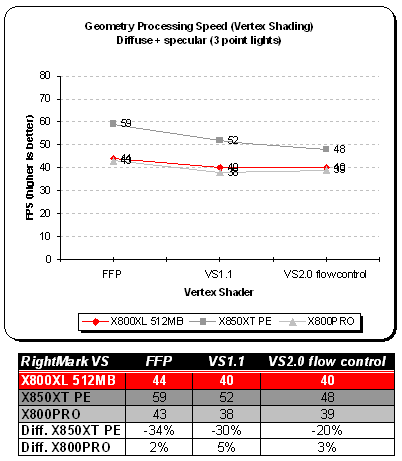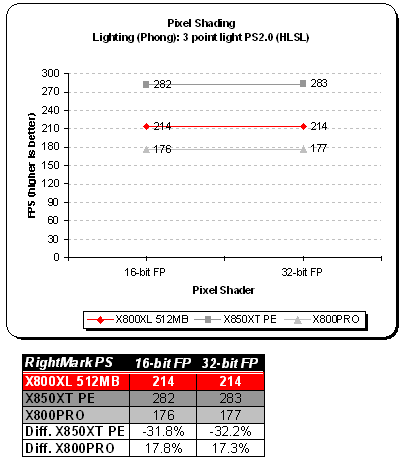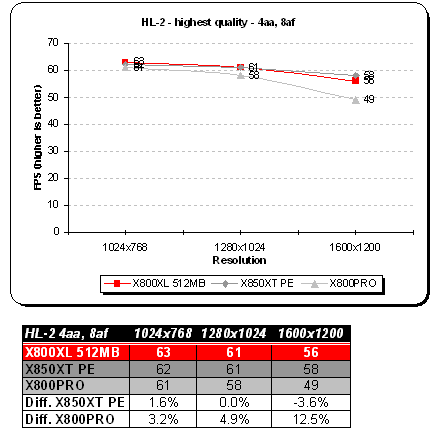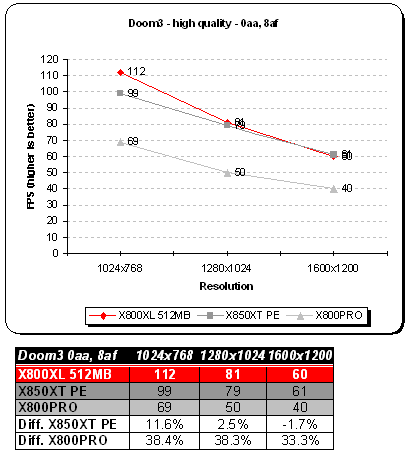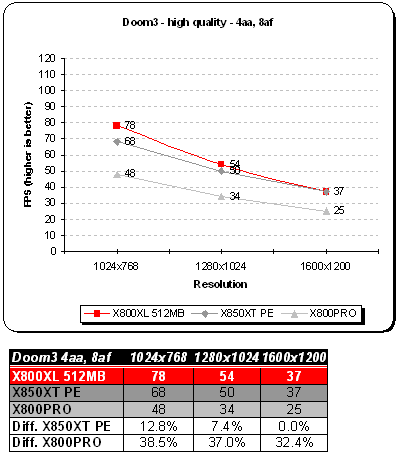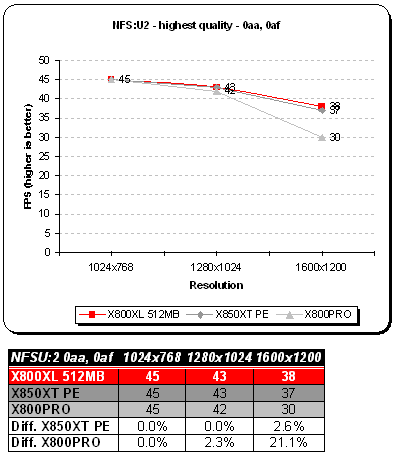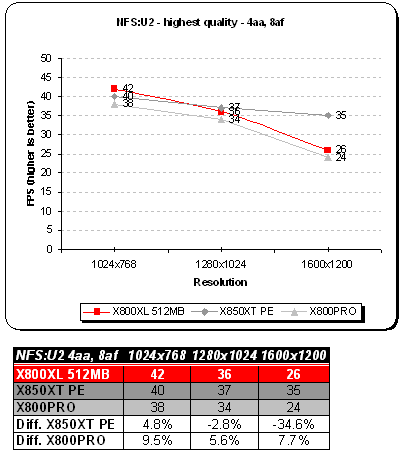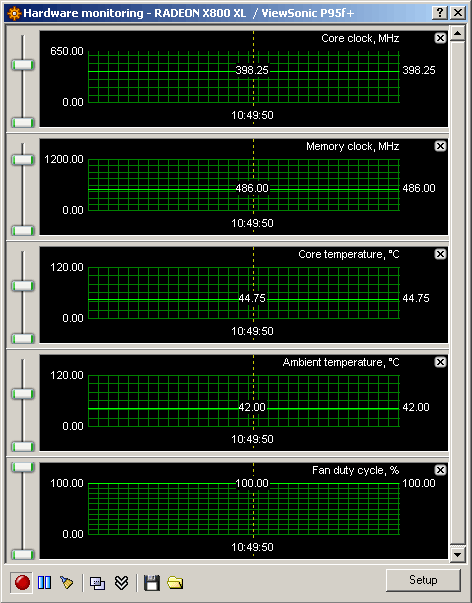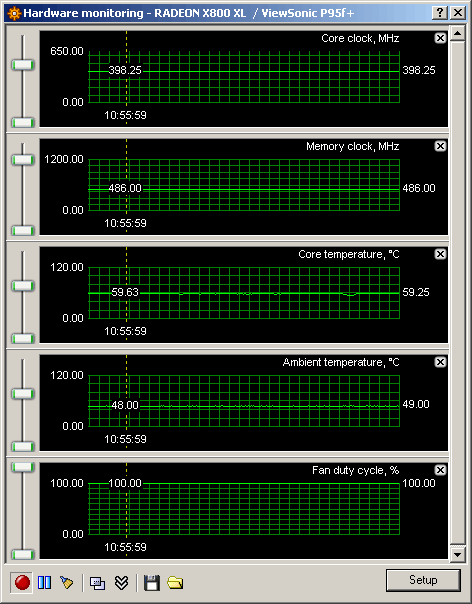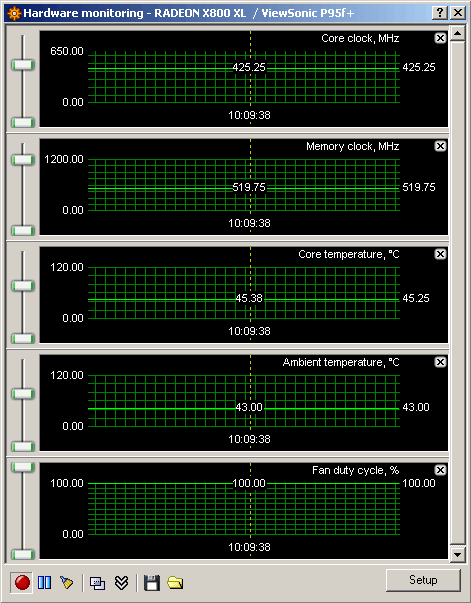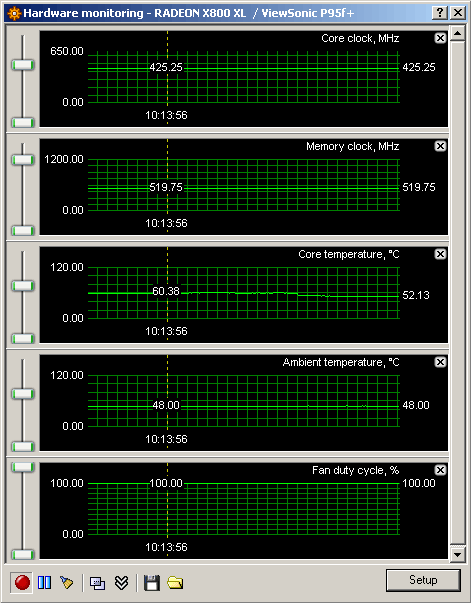I recommend this card to anyone who can’t afford an X850 XT PE / GeForce 6800 Ultra or G70, but with limited pieces it would be quite impossible to get a hold of one. My only two gripes with this card are poor overclock results and outdated bundle; other than that it’s a fine and stable card. In many situations performance is on par with X850 XT PE and in others even better.
Introduction
Is bigger always better? Well it’s fairly hard to answer this question with one sentence, but delving into the problem might give us some clues and ideas. I’m sure a lot of you’ve been waiting for a video card that will finally sport half-a-gig of RAM. Some will ask, do we really need 512MB’s of memory on a video card? We sure will, maybe not this year, but it will definitely boost performance in applications that use very high resolution textures with additional FSAA turned on. I don’t want to rant on this topic as it’s not the right place and time, let’s just see what we can squeeze out of this beast.
Okay, so what if I told you that in addition to 512MB’s of RAM, our PowerColor X800 XL is passively (sort of) cooled? If you don’t know what I mean, check out our PowerColor Bravo X700 review to see what I’m talking about. The XL version comes with a similar system, but greatly improved. The SCS2 (Silent Cooling Solution 2) is what keeps the PowerColor X800 XL cool and quiet.
For those not in the know Tul Corporation is a Tier-1 provider of ATI-based graphic cards. The company is also a leader in providing motherboards and barebone systems. So what about PowerColor?
PowerColor is a consumer brand focused on providing cutting-edge graphics card products to retail customers. Our goal for the Tul brand is to be the industry’s number one provider of technology product solutions. Our goal for the PowerColor brand is to be the world’s number one brand of graphics cards. PowerColor is in effect owned by Tul Corporation, however the brands are operated independently of each other.
I would like to thank Tul Corporation for sending us a sample of PowerColor X800 XL 512MB. This is a very rare unit as availability will be limited. Around 100 pieces will go into Europe and another 200 will be distributed in Asia and maybe United States.
VPU Specifications
When you look at the specifications of the PowerColor X800 XL 512MB, they are very similar to R480. Obvious differences are chip architecture, frambuffer size and clock speeds. ATI’s move to bring better performance cards at lower cost paid off. Since 110nm process is much cheaper than 113nm low-k, ATI has filled in a gap they’ve created with fairly high-end 12 pixel pipeline X800 PRO. The XL model is here to compete against 16 pixel pipeline GeForce 6800GT and it does so pretty well.
| PowerColor |
X800 XL 512MB
|
X850 XT PE
|
X800 PRO LAE
|
Bravo X700
|
| VPU (256-bit) |
R430
|
R481
|
R420
|
RV410
|
| Chip Architecture |
.11µ (TSMC fab)
|
.13µ low-k (TSMC fab)
|
.13µ low-k (TSMC fab)
|
.11µ (TSMC fab)
|
| Transistors |
~160 Million
|
~160 Million
|
~160 Million
|
~120 Million
|
| Memory Architecture |
256-bit
|
256-bit
|
256-bit
|
128-bit
|
| Frame Buffer Size |
512 MB GDDR-3
|
256 MB GDDR-3
|
256 MB GDDR-3
|
256 MB GDDR-2
|
| Pixel Pipelines |
16
|
16
|
12
|
8
|
| Vertex Pipelines |
6
|
6
|
6
|
6
|
| TMU(s) per Pipeline |
1
|
1
|
1
|
1
|
| Engine |
SMARTSHADER HD
|
SMARTSHADER HD
|
SMARTSHADER HD
|
SMARTSHADER HD
|
| Bus Type |
PCI-e 16x
|
AGP 8x, 4x
|
AGP 8x, 4x
|
PCI-e 16x
|
| Core Clock |
400 MHz
|
540 MHz
|
475 MHz
|
400 MHz
|
| Memory Clock |
980 MHz DDR
|
1180 MHz DDR
|
900 MHz DDR
|
532 MHz DDR
|
| RAMDACs |
2x 400 MHz DACs
|
2x 400 MHz DACs
|
2x 400 MHz DACs
|
2x 400 MHz DACs
|
| Memory Bandwidth |
32 GB / sec
|
37.6 GB / sec
|
28.8 GB / sec
|
8.5 GB / sec
|
| Pixel Fillrate |
6.4 GPixels / sec
|
8.6 GPixels / sec
|
5.7 GPixels / sec
|
3.2 GPixels / sec
|
| Texel Fillrate |
6.4 GPixels / sec
|
8.6 GTexels / sec
|
5,7 GTexels / sec
|
3.2 GPixels / sec
|
| DirectX Version |
9.0c
|
9.0c
|
9.0c
|
9.0c
|
| Pixel Shader |
2.0b
|
2.0b
|
2.0b
|
2.0b
|
| Vertex Shader |
2.0
|
2.0
|
2.0
|
2.0
|
SMARTSHADER™ HD
- Support for Microsoft® DirectX® 9.0 programmable vertex and pixel shaders in hardware
- DirectX® 9.0 Vertex Shaders
- Vertex programs up to 65,280 instructions with flow control
- Single cycle trigonometric operations (SIN & COS)
- DirectX® 9.0 Extended Pixel Shaders
- Up to 1,536 instructions and 16textures per rendering pass
- 2nd generation F-buffer technology accelerates multi-pass pixel shader programs with unlimited instructions
- 32 temporary and constant registers
- Facing register for two-sided lighting
- 128-bit, 64-bit & 32-bit per pixel floating point color formats
- Multiple Render Target (MRT) support
- Complete feature set also supported in OpenGL® via extensions
SMOOTHVISION™ HD
- 2x/4x/6x Anti-Aliasing modes
- Sparse multi-sample algorithm with gamma correction, programmable sample patterns, and centroid sampling
- Lossless Color Compression (up to6:1)at all resolutions, including widescreen HDTV resolutions
- Temporal Anti-Aliasing
- 2x/4x/8x/16x Anisotropic Filtering modes
- Up to 128-tap texture filtering
- Adaptive algorithm with bilinear (performance) and trilinear (quality) options
3Dc™
- High quality 4:1 Normal Map Compression
- Works with any two-channel data format
HYPER Z™ HD
- 3-level Hierarchical Z-Buffer with Early Z Test
- Lossless Z-Buffer Compression (up to 48:1)
- Fast Z-Buffer Clear
- Z Cache optimized for real-time shadow rendering
- Optimized for performance at high display resolutions, including widescreen HDTV resolutions
VIDEOSHADER™ HD
- Seamless integration of pixel shaders with video in real time
- FULLSTREAM™ video de-blocking technology for Real, DivX, and WMV9 formats
- VIDEOSOAP™ noise removal filtering for captured video
- All-format DTV/HDTV decoding
- Adaptive Per-Pixel De-Interlacing and Frame Rate Conversion (temporal filtering)
DISPLAY FEATURES
- Dual integrated display controllers
- Dual integrated 10 bit per channel 400 MHz DACs
- Integrated 165 MHz TMDS transmitter (DVI 1.0 / HDMI compliant and HDCP ready)
- Integrated TV Output support up to 1024×768 resolution
- YPrPb component output for direct drive of HDTV displays†
- Single and dual link external TMDS transmitter support for high resolution and/or multi-monitor DVI configurations
- Compatible with ATI’s THEATER™ video decode and capture devices for VIVO (Video Input / Video Output) configurations on certain X800 graphic cards
ADDITIONAL FEATURES
- Windows® Logo Program compliant
- CATALYST™ Software Suite
In terms of feature set, there are no major differences from R300 / R350 VPUs, except for improved pixel / vertex shader instructions and additional map compression.
The Card
The problem with most high-end cards these days is loud cooling solution and many times dual-slot system. Have you ever heard of a passively cooled high-end card with 512MBs of memory? Not until now right? If you look back at our PowerColor Bravo X700 review, we went over the SCS technology used to cool down the core and memory of the board. PowerColor X800 XL features an updated Silent Cooling System called SCS2.
Sizewise the PCB is much longer than X700’s. The heavy aluminum heatsink covering the VPU and RAM is also a bit bigger than its predecessor. If you notice on the left image, not all memory modules are even covered — very bad idea as those chips get hot fast! There are 8 memory chips on each side (16 in total) — that’s 32MBs for a module, making it up to 512MB.
As you can see from above images the aluminum block of SCS2 is bigger and now features a different fan.
For better heat circulation and dissipation both blocks are connected with copper heatpipes (5mm, 6mm x2). To help transport the heat an already mentioned low-speed smart fan is used. This solution isn’t natively silent, but the sound level doesn’t reach 19dB. Onboard smart fan will spin faster as GPU temperature goes up, ie. the speed of the fan will automatically adjust. Tul also says that SCS2 technology will extend your GPU life by 20%.
Here we have a 4-pin PCI-e Y power connector needed to supply enough juice to the GPU. Next is the back plate sporting dual DVI-I as well as VIVO through ATI’s Rage Theater chip. The chip gives the card VIVO capabilities inlcuding video encoding / decoding.
What you are looking at is ATI’s Rage Theater Chip (features below) as well as SAMSUNG K4J55323QF-GC16 1.6ns memory module (16 all together) rated at 600 MHz.
ATI Rage Theater
- High Quality Integrated Video Encoder / Decoder with Digital Audio Support
ATI RAGE THEATER is a low cost, single chip, multi-standard video encoder/decoder that elevates video on the PC to the next level of integration, performance and affordability. Its advanced processing features are designed to generate a superior video out image, making it particularly suited for applications such as TV Web browsing. With its wide range of video inputs, multiple clock outputs, GPIO pins, I²S and S/PDIF audio, RAGE THEATER offers manufacturers the cost-cutting opportunity to substantially reduce the number of components in home-theatre and set-top-box appliances. - High Quality TV-out
RAGE THEATER video encoder converts images of Windows, Mac OS, DVD movies or games into all NTSC and PAL formats for TV viewing. The encoder uses programmable timing to generate high quality TV signals from graphics display modes ranging from 320×200 to 800×600. This provides full support of legacy VGA modes as well as the newer, low-resolution game modes required by Microsoft DirectX. - High Quality Video-in
RAGE THEATER’s adaptive comb filter and advanced on-chip circuitry ensures that Composite and S-Video analog inputs in NTSC, PAL, and SECAM format are converted into high quality, low noise digital video for a sharper image. In addition, RAGE THEATER provides a full range of VBI services that includes Teletext, Closed Captioning, and Intercast. - Glueless Chip Level Interface
RAGE THEATER supports a glueless interface, through both ATI Multimedia Channel and VESA VIP 1.1 buses, to all existing and future ATI graphics controllers, on either a motherboard or an add-in graphics card. - Standard Compliance
RAGE THEATER complies with Macrovision (the analog copy-protection standard stipulated by the DVD industry) and CGMS-A (Copy Generation Management System – Analog)
Bundle
In terms of package and bundle you’ll find a standard PowerColor box with accessories and software. You won’t find any new games inside the box, an old Hitman Contracts is included along with CyberLink DVD Solutions. Let’s move into some details.
The front of the box and PowerColor X800 XL 512MB card laying next to it. The second image shows all accessories, manual and software.
The front and back of the box highlight cards specifications and features. In the middle of the box you are presented with a nicely rendered image — looks like an angel to me. The back of the box sports specs and some catch phrases. The sides show system requirements. Overall I was pleased with the design of the box, nothing fancy just useful information.
Manual and software on the left and cables / connectors on the right hand side. At the time of taking the pictures the card was inside the system so I forgot to include the PCI-e Y power cable in the scene. Here is a list of stuff Tul includes with their PowerColor X800 XL graphic card:
- Accessories
- HDTV Cable
- Video in/out Cable
- S-Video Cable
- Composite Cable
- DVI-I Connector
- PCI-e Y Power Cable
- User’s Manual
- Software bundle
- Driver CD
- CyberLink DVD Solutions
- PowerDVD 5
- PowerProducer 2 Gold DVD
- PowerDirector 3
- Power2Go 3
- Medi@show 2
- Hitman: Contracts full game
Setup and Installation
All of our benchmarks were ran on two different systems: PCI-e & AGP. I will be comparing our PowerColor X800 XL 512MB to other PowerColor graphic cards I’ve reviewed in the past. The table below shows test system configurations as well benchmarks used throughout the review.
| PCI-e system | AGP system | |
| Components |
– DFI NF4 Ultra-D |
– Abit NF7-S 2.0 – Athlon XP 2800+ – 3x256MB Corsair PC3200LLP – Chaintech 420 Watt PSU – PowerColor X850XT PE – PowerColor X800 PRO |
| Software | – Windows XP SP2 – DirectX 9.0c – nForce4 6.53 drivers – CATALYST 5.6 |
– Windows XP SP2 – DirectX 9.0c – nForce2 5.10 drivers – CATALYST 5.4 |
| Synthetic Benchmarks | – 3DMark 2005 v1.2.0 – D3D Right Mark 1.0.5.0 beta 4 |
– 3DMark 2005 v1.2.0 – D3D Right Mark 1.0.5.0 beta 4 |
| Gaming Benchmarks | – Doom 3 / demo1 – Half-Life 2 / d13c17 demo – NFS: Underground 2 |
– Doom 3 / demo1 – Half-Life 2 / d13c17 demo – NFS: Underground 2 |
| Notes | CPU was clocked at default 1.8GHz | CPU was clocked at 2.1GHz |
As far as installation goes I decided to pick a DFI NF4 Ultra-D motherboard for the PCI-e system — that should give my “Venice” Athlon some headroom. The only thing I don’t like about using this motherboard is the chipset cooler and PCI Express x16 slot placement. I was pretty skeptical when putting PowerColor X800 XL card in. There is nothing wrong with the card though, it’s made to specs, so is this DFI motherboard, but take a look at this potential problem:
There is maybe 2 millimeters of space between the chipset cooler and the card’s PCB
Note that the card is not completely locked in the slot!
So there it is, maybe I’m a bit too harsh on DFI, but as I mentioned above the card does not lock in completely inside the slot. If you push the back of the card and lock it, the chipset fan will interfere with the PCB and will not spin, resulting in failure of the fan or chipset overheating. This situation may cause instability problems down the road so keep that in mind. Although this is a minor obstruction, the card is well seated and should not cause any issues.
Other than the above, I haven’t had any problems installing or configuring PowerColor X800 XL 512MB. Let’s move on.
Synthetic Benchmarks
3DMark05
I’ve used Futuremark’s 3DMark 2005 for measuring the actual throughput of our PowerColor X800 XL 512MB and compared it against PowerColor’s X850 XT Platinum Edition as well as the 12-pipeline PowerColor X800 PRO.
| PowerColor |
X800 XL 512MB
|
X850 XT PE
|
X800 PRO LAE
|
| Pixel Fillrate |
3037,2 MPixels / sec
|
3654,3 MPixels / sec
|
2726,7 MPixels / sec
|
| Texel Fillrate |
6332,3 MTexels / sec
|
8542,8 MTexels / sec
|
5707,4 MTexels / sec
|
| Geometry Rate |
400 MTriangles
|
540 MTriangles
|
475 MTriangles
|
| Vertex Shader – Simple |
55,6 MVertices / sec
|
62,1 MVertices / sec
|
50,7 62,1 MVertices / sec
|
| Vertex Shader – Complex |
37,1 MVertices / sec
|
49,7 MVertices / sec
|
44,1 MVertices / sec
|
| Pixel Shader (2.0b) |
123,1 FPS
|
154,6 FPS
|
104,4 FPS
|
Even with much lower core clock (400 MHz), X800 XL does as expected. Synthetic test scores are listed above. Let’s take a look at 3DMark05 game tests.
Performance difference between higher ranked X850 XT PE is roughly 13% in Game Test 1 & 2. In GT3 PowerColor X800 XL 512MB scores 24 FPS right in between X850 XT PE and X800 PRO. Extra 256MB’s of RAM doesn’t seem to affect card’s performance in 3DMark05 at all. Raising the clock speeds of X800 XL should marginally improve those scores, but don’t expect anything out of ordinary.
RightMark
D3D RightMark is a very useful tool for measuring different theoretical throughputs of a graphics chip. I ran couple of synthetic tests to stress out our PowerColor X800 XL and stacked it against PowerColor X850 XT PE and X800 PRO too see how it managed in Geometric Processing (Vertex Shading) as well as Pixel Shading tests.
With D3D RightMark you will be able to get the following information about your video card:
- Features supported by your video card
- Pixel Fillrate and Texel Fillrate
- Pixel shader processing speed (all shader models)
- Vertex shader (geometry) processing speed (all shader models)
- Point sprites drawing speed
- HSR efficency
In this test, we are looking at the vertex shader’s (geometry) processing speed. I chose Diffuse + specular (3 point lights) for our lightning profile which is probably the most useful setting. This will give us peak geometrical throughput. In order to get a clearer overlook, three different shader profiles were used: Fixed Function Pipeline (FFP) VS1.0 and VS 2.0 flow control.
As you can see, there is a 34% difference between X850 XT PE and X800 XL when it comes to Fixed Function Pipeline (FFP). Note that FFP mode is stressing standard Transform & Lightning pipeline whereas VS1.1 and VS2.0 are stressing the geometry processing pipeline (vertex pipeline). X800 PRO does similarly as the XL in all tests, though there is a 5% difference in VS1.1 test.
Let’s have a look at the pixel shading performance. Lightning (Phong) PS 2.0 shading profile is a very good synthetic test that nicely stresses the pixel pipeline. You can choose all current Shader Models ranging from PS 1.1 all the way up to PS 3.0. In our case we are looking at Pixel Shader 2.0 and 16-bit / 32-bit floating point numbers. At 1024×768, the Lightning (Phong) PS 2.0 benchmark ran at 214 FPS under 16-bit FPS and 214 FPS under 32-bit FP. That’s almost 18% more frames than with X800 PRO, but 32% less than the high-end X850 XT PE.
While this is it for synthetic stressing, let us focus more on gaming experience PowerColor X800 XL 512MB brings.
Half-Life 2
Okay it’s time to pick up the crowbar once again!
We all love Half-Life 2 and we all want best performance out of our hardware. This has to be one of the most graphic demanding games currently on the market. Half-Life 2 is built around Source engine which utilizes a very wide range of DirectX 8 / 9 special effects. Those include:
- Diffuse / specular bump mapping
- Dynamic soft shadows
- Localized / global valumetric fog
- Dynamic refraction
- High Level-of-Detail (LOD)
Note that users with DirectX 7 and older hardware (NVIDIA MX series for example) will not be able to enjoy the above effects. Let’s see what X800 XL is made of.
I have benched Half-Life 2 using HardwareOC Half-Life 2 Benchmark tool and their custom d13c17 demo. It seems there is a CPU limitation as all cards perform similarly especially at first two resolutions. Power Color X800 XL beats the high-end brother by 1 FPS at 1024×768, though ends up with 59 FPS at 1600×1200, that’s 5.1% less than the X850 XT PE.
Again, PowerColor X800 XL 512MB shows its teeth with 4xAA / 8xAF enabled. There isn’t a big performance gap between the three cards except for X800 PRO’s last run which results in 12.5% less FPS than XL. Above scores indicate very little performance loss when applying Antialiasing as well as Anisotropic Filtering.
Doom 3
Now that we are past Doom 3s release, some gamers have been left with a bit of disappointment. Main reason is Half-Life 2 and its Source engine which really showed a vast amount of potential and scalability.
Although this game needs no introduction, I will go over some of the game features and technology behind Doom 3. It took the guys at id Software over four years to complete this project. Lead programmer, John Carmack spent an awful lot of time designing the game engine, but his hard work paid off — to some extent since this is first title which houses Doom 3 engine.
Let’s look at some of the engine tech features which are present in Doom 3:
- Unified lightning and shadowing engine
- Dynamic per-pixel lightning
- Stencil shadowing
- Specular lightning
- Realistic bumpmapping
- Dynamic and ambient six-channel audio
However you look at it, Carmack’s lightning engine is the essence of Doom 3. With OpenGL being the primary API, shaders have been put to a heavy use in order to create the realisticly looking environment. Instead of using lightmaps the game engine now processes all shadows in real-time. This technique is called stencil shadowing which can accurately shadow other objects in the scene. There are disadvantage to this method however:
- Requires a lot of fillrate
- Fast CPU is needed for shadow calculations
- Inability to render soft shadows
CATALYST drivers had improved greatly since Doom 3 introduction. There were some issues and stuttering with early drivers, but it looks like CATALYST team has been ironing things out. Would additional 256 MBs of RAM make a difference with this title? Let’s take a look at the benchmarks to find out.
With similar (performance wise) system setup, PowerColor X800 XL equipped with 512MBs of RAM passes with flying colors. There is a significant performance spike at 1024×768 — 11.6% better than X850 XT PE. I checked it twice, XL does render the screen faster.
Similar situation with 4 x Antialiasing and 8 x Anisotropic Filtering enabled. Our X800 XL outperforms the X850XT PE at both 1024×768 and 1280×1024 resolutions.
You might be asking how am I getting such high scores. Well, I don’t have a clear explanation to that, but it might be because I’m not using any Doom 3 patch. I will have to investigate those benchmarks because they do look quite high.
Need For Speed: Underground 2
Another DirectX 9 title with nicely shaped up graphics. The neverending title from EA Sports has brought many plenty of fun as with previous NFS series. The game uses various effects mostly found in Shader Model 2.0 such as motion blur, light / glow trails or reflections. The good thing is, all those effects are compatible when Antialiasing is enabled.
Both X800 XL and X850 XT PE performed on par. X800 PRO on the other hand stayed behind at 30 FPS and 1600×1200 resolution.
With AA and AF enabled PowerColor X800 XL 512MB rocks at 42 FPS and 1024×768 screen resolution. At 1600×1200 there was a 10 FPS drop compared to X850 XT PE which only lost 2 frames per second. It seems that much lower core clock (400MHz) contributed to this loss.
Overclocking and Temperatures
With such horsepower and cooling system it would be a waste not to see how far PowerColor’s X800 XL 512MB can be pushed. Although BIOS readings show 400 MHz core and 490 MHz memory (980 MHz effective), by default the card is clocked at 398 MHz core and 486 MHz RAM (972 MHz effective). As I mentioned couple of pages before, the card comes equipped with 1.6ns SAMSUNG K4J55323QF-GC16 memory modules which are rated at 600 MHz.
Okay so you are automatically thinking that RAM clocked at 490 MHz would yield 600 MHz without any effort right? Afterall, these are SAMSUNG memory specifications. To tell you the truth, those were exactly my initial thoughts, but further testing proved me wrong. Note that throughout our overclocking procedures, fan was working at full speed. This resulted in much lower temperatures compared to other XL cards. Let’s take a look at RivaTuner hardware monitor readings.
Room temperature: 22C, default clocks, fan 100%, idle:
Here, our card is clocked at default speeds which produces 44.75C core temperature. Environment temperature is at 42C.
Room temperature: 22C, default clocks, fan 100%, load:
Playing GTA: San Andreas and doing additional 3DMark Game Test run produces 59.63C temperature. Environment reading shows 49C.
Room temperature: 22C, max overclock, fan 100%, idle:
Maximum stable and artifact free overclock: 425 MHz core, 520 MHz memory (1040 MHz effective). This overclock yields 45.38C core temperature and 43C for ambient temperature.
Room temperature: 22C, max overclock, fan 100%, load:
As you might have noted, overclocking both the VPU and RAM won’t increase the temperatures significantly. At full load RivaTuner reads just over 60C core temperature. Obviously memory won’t even overclock to 550 MHz (1100 MHz effective), not to mention SAMSUNG rated 600 MHz. Same with the VPU, 425 MHz is just below average.
One reasonable answer to this problem are low voltages in BIOS which lead to poor overclock rates. It seems to me as Tul is lowering memory voltages inside the BIOS. Evidently those poor results are not because of high temperatures or weak heat circulation. Again, temperatures seem very low and there is plenty of room for more MHz.
Conclusions
The introduction of RADEON X800 XL was a spot on choice for ATI. What about the ability for IHVs to slap on 512MBs of RAM? Isn’t this an overkill at least this year? In my opinion this move could have waited as there are very rare performance benefits from higher framebuffer. Sure Doom 3 has Ultra High mode, but it’s hard to notice image quality differences. Albeit I didn’t have a regular XL on hand and couldn’t do a more detailed comparison between both cards, Doom 3 yielded interesting results.
I recommend this card to anyone who can’t afford X850 XT PE / GeForce 6800 Ultra or G70, but with limited pieces it would be quite impossible to get a hold of one. My two major gripes with this card are poor overclock results and outdated bundle, other than that it’s a fine and stable card. In many situations performance is on par with X850 XT PE and in others even better.
PowerColor X800 XL 512MB up and running
Another shot this time from the top
Pros:
+ 16 Pixel Pipelines
+ Great performance
+ Highly improved SCS cooling technology
+ Low VPU temperature
+ Low speed adjustable smart fan
+ VIVO capabilities through ATI Rage Theater chip
+ Nice package
Cons:
– Poor overclocking results
– Limited availability
– Currently no benefit from higher framebuffer
– Outdated bundle
For great performance, innovative cooling technology and low temperatures PowerColor X800 XL 512MB gets the rating of 8.5 (Very Good) out of 10 and Bjorn3D.com Seal of Approval.
 Bjorn3D.com Bjorn3d.com – Satisfying Your Daily Tech Cravings Since 1996
Bjorn3D.com Bjorn3d.com – Satisfying Your Daily Tech Cravings Since 1996



















